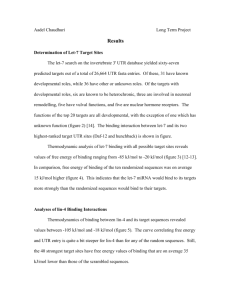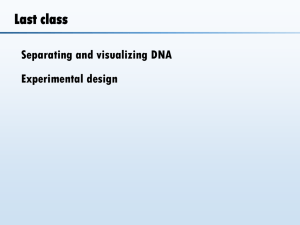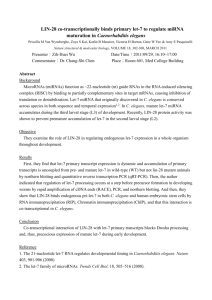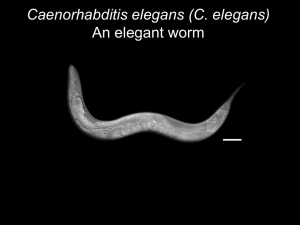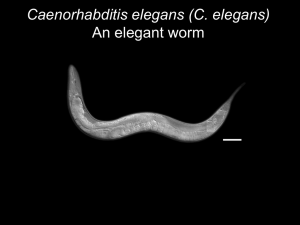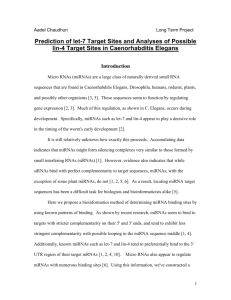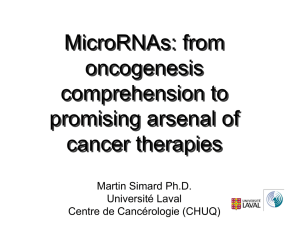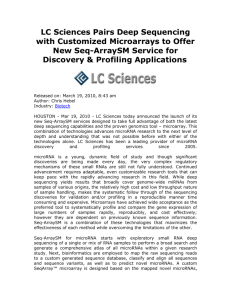let-7-Fam -3
advertisement
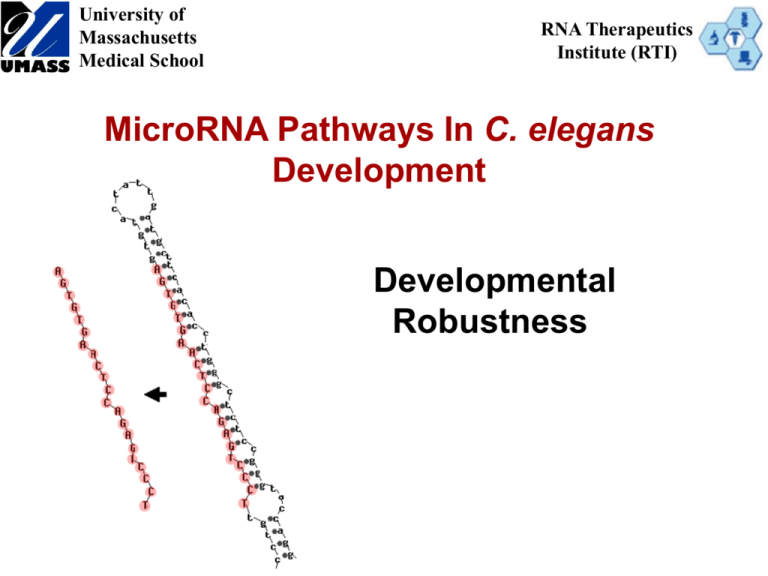
University of Massachusetts Medical School RNA Therapeutics Institute (RTI) MicroRNA Pathways In C. elegans Development Developmental Robustness Regulation of Gene Expression by Animal MicroRNAs Invertebrates: ~150 microRNA genes Vertebrates: ~1000 microRNA genes microRNA gene Inhibition of protein production from mRNA targets Pri-microRNA Effectors GW AGO NHLAGO Modulators AGO Pre-microRNA miRNP An How Did/Do MicroRNAs Evolve? Hsa-mir-100 AACCCGUAGAUCCGAACUUGUG Cel-mir-52 CACCCGUACAUAUGUUUCCGUGCU One Pan-Eumetazoan family Human let-7-Family Worm let-7-Family UGAGGUAGUAGGUUGUAUAGUU UGAGGUAGUAGGUUGUGUGGUU UGAGGUAGUAGGUUGUAUGGUU AGAGGUAGUAGGUUGCAUAGUUGAGGUAGGAGGUUGUAUAGUUGAGGUAGUAGAUUGUAUAGUU UGAGGUAGUAGUUUGUACAGUUGAGGUAGUAGUUUGUGCUGU- UGAGGUAGUAGGUUGUAUAGUU UGAGGUAGGCUCA-GUAGAUGC UGAGGUAGUAUGUAAUAUUGUA UGAGGUAGGUGCGAGAAAUGA- > 35 novel Pan-Bilaterian families MicroRNAs are Endogenous RNAi Agents ~800 human lancelet fly 1 beetle Eumetazoa RNAi roundworm Animals sea anenome sponge Plants weed Fungi mould ~10 >100 ~10 ~150 Evolutionary fluidity of target gene sets Explicitly-Homologous Worm Fly Human hsa-miR-1 UGGAAUGUAAAGAAGUAUGUAU cel-miR-1 UGGAAUGUAAAGAAGUAUGUA dme-miR-1 UGGAAUGUAAAGAAGUAUGGAG Chen and Rajewsky CSHS 2006 Evolution of MicroRNA-Target Interactions C. elegans hypodermal lineages Explicitly-Homologous Functionally-Analogous let-60/Ras let-7 HBL-1 LIN-28 LIN-41 human cells let-7 differentiation tumor Hmga2 normal Mayr, Hemann and Bartel, 2007 Functions of microRNA genes in C. elegans lin-4 and let- 7 control developmental timing (1993, 1999). ••••• Single gene visible phenotypes ••••• C. elegans “Heterochronic” Mutants Retarded Development of lin-4 mutants Wild Type lin-4- LIN-14 over-expression Adult Alae Formation at L4 Molt ALAE lin-4 L3 Molt L4 Molt lin-14 3’ UTR Deletion Utterly Cell Fate Specification andprogression Execution lin-4 andRobust let-7 microRNAs control cell fate Embryo Larval stages lin-14 lin-4 lin-14 hbl-1 7-Fam hbl-1 lin-41 let-7 lin-41 1 2 3 4 Adult Adult lin-14 ..C ACCAA C.. lin-41..A hbl-1 ...U UCACA CUUGU CUCAGGGA AUU U.. lin-4 AACUA AGUGU UUAUACAACC CC GAGUCCCU GCUACCUUA CUGCCUC UUGAU GAUAUGUUGG G GG A UGAUGGAGU GAUGGAG let-7 mir-84 UU AUGUU A C AU A U ACUC Genetics of microRNA genes in C. elegans lin-4 and let- 7 control developmental timing (1993, 1999). ••••• Single gene visible phenotypes ••••• Most Caenorhabditis elegans microRNAs are individually not essential for development or viability. Miska, Abbott, Alvarez-Saavedra …Bartel, Ambros, Horvitz. PLoS Genet. (2007) The let-7 MicroRNA family … mir-48, mir-84, and mir-241 function together to regulate developmental timing in C. elegans. Abbott et al…Bartel, Horvitz, Ambros. Dev. Cell. (2005) Many families of Caenorhabditis elegans microRNAs are not essential for development or viability Ezequiel Alvarez-Saavedra and H. Robert Horvitz Curr Biol. 2010 The microRNA miR-1 regulates a MEF-2-dependent retrograde signal at neuromuscular junctions. Lucky! A drag… No New Phenotypes Redundancy within a microRNA family 3 of 15 families are essential Stress the worms Simon et al…Ruvkun, Kaplan, Kim. Cell. (2008) Loss of individual microRNAs causes mutant phenotypes in sensitized genetic backgrounds in C. elegans. Brenner et al, … Abbott. Curr Biol. (2010) Visible Phenotypes for 25 of 31 miRNA genes • Redundancy between microRNA families microRNAs Are Embedded Within Diverse Networks mir-34 Gonadal Morphogenesis Argonaute mir-83 • Redundancy with gene regulatory “hubs” Robustness thru Redundancy Loss of individual microRNAs causes mutant phenotypes in sensitized genetic backgrounds in C. elegans. Brenner et al, 2010 mir-1 Fertility Distinct MicroRNAs with Convergent Targets Buffering morphogenetic processes against temperature changes B-integrin PAT-3 Buffered against pat-3 mRNA mir-83 mir-34 peb-1 mRNA Gonadal Morphogenesis Temperature changes PEB-1 Transcription factor Samantha Burke & Molly Hammell Hermaphrodite Gonad Morphogenesis in C. elegans Phase 1 Phase 2 Phase 3 From Worm Atlas Migration Defects in mir-34 (-/-) and mir-83 (-/-) Mutants *** Wild type 80 60 40 17 20 60 40 20 ir83 (-/ -) 0 (-/ -); m ir83 80 m ir34 m ir34 m n=200 (-/ -) 5 0 N 2 0 8 100 % of gonad arms scored Migration defective (-/ -) % of gonad arms scored 100 Samantha Burke & Molly Hammell 100 *** 100 Taking a Cue from Richard Carthew…. Drosophila mir-7 Buffers Eye Development Against Temperature Changes Li et al., Carthew Cell 2009 137(2): 273-282 Temperature Oscillations Aggravate mir-34 & mir-83 Phenotypes 15oC – 25oC Oscillations (8 hr) r-8 3 r-3 4 (-/ d arms scored *** Migration defective 80 Wild type 60 60 Samantha Burke & Molly Hammell N2 *** 100 80 12 0 mi 100 6 4 -) 3 r-8 i m 3 14 20 (-/ r-8 mi (-/ (-/ -) (-/ 2 -); mi 4 -) 0 40 mi r-3 r-3 -) N2 n=200 19 6054 mi r-8 mi r-3 3( 4( -/-) -/-) ;m ir-8 3( -/-) 0 14 20 N2 5 mi 0 8 mi r-3 4( -/-) 17 20 40 Wild type 80 (-/ -) 60 Migration defectiv mi r-3 60 % of gonad arms scored Wild type 80 (-/ % of gonad arms scored 80 40 100*** 100 defective Migration % of gonad arms scored *** 100 100 d arms scored Constant 20 ℃ 80 64 60 -); 4 *** *** Migration defe Wild type % defective gonadal migration *** 54 14 19 2 mir-83(+) mir-34(+) mir-83(0) mir-34(+) mir-83(+) mir-34(0) Samantha Burke & Molly Hammell mir-83(0) mir-34(0) Distinct MicroRNAs with Convergent Targets Buffering morphogenetic processes against temperature changes B-integrin PAT-3 Buffered against pat-3 mRNA mir-83 mir-34 peb-1 mRNA Gonadal Morphogenesis Temperature changes PEB-1 Transcription factor Samantha Burke & Molly Hammell Post-dauer: mir-48, mir-84, mir-241, let-7 lin-4: MAJOR Role Continuous: lin-4: minor role NHL-2 mir-48, mir-84, mir-241, let-7 AGO let-7 Family lin-4 An Modulation of microRNA levels and (lin-4) activity Xantha Karp Accommodation of Stress and Diapause in C. elegans Development Favorable Unfavorable Larval stages 1 Insulin/IGF DAF-16/Fox0 2 Dauer larva 3 4 Adult Continuous Dauerinterrupted Utterly Cell Fate Specification andprogression Execution lin-4 andRobust let-7 microRNAs control cell fate Embryo Larval stages lin-14 lin-4 lin-14 hbl-1 7-Fam hbl-1 lin-41 let-7 lin-41 1 2 (Optional) Developmental Quiescence 3 4 Adult Adult lin-14 ..C ACCAA C.. lin-41..A hbl-1 ...U UCACA CUUGU CUCAGGGA AUU U.. lin-4 AACUA AGUGU UUAUACAACC CC GAGUCCCU GCUACCUUA CUGCCUC UUGAU GAUAUGUUGG G GG A UGAUGGAGU GAUGGAG let-7 mir-84 UU AUGUU A C AU A U ACUC lin-4 and let-7 microRNAs control cell fate progression Embryo Larval stages lin-14 lin-4 lin-14 hbl-1 7-Fam hbl-1 lin-41 let-7 lin-41 1 2 (Optional) Developmental Quiescence 3 Dauer larva 4 Adult Adult Robust Timing of cell fates microRNAs in C. elegans cell fate progression Developmental Signals Wild type lin-4 LIN-14 LIN-28 L1 L2 miR-48 L3 Dauer Larva Quiescence miR-84 HBL-1 let-7Fam mir-48 mir-84 mir-241 let-7 L4 let-7 LIN-41 miR-241 LIN-29 Ad MicroRNA pathways lin-4 Transcription Factors let-7 Robust Timing of cell fates Dosage-Sensitive activity of let-7-Family microRNAs Worm let-7-Family Developmental Signals UGAGGUAGUAGGUUGUAUAGUU UGAGGUAGGCUCA-GUAGAUGC UGAGGUAGUAUGUAAUAUUGUA UGAGGUAGGUGCGAGAAAUGA- lin-4 Wild type -1 let-7-Fam LIN-14 LIN-28 let-7Fam L1 L2 L2 L3 L3 L4 L4 Ad Ad HBL-1 mir-48 mir-84 mir-241 let-7 let-7 L1 LIN-41 LIN-29 Dosage-Sensitive activity of let-7-Family microRNAs Worm let-7-Family Developmental Signals UGAGGUAGUAGGUUGUAUAGUU UGAGGUAGGCUCA-GUAGAUGC UGAGGUAGUAUGUAAUAUUGUA UGAGGUAGGUGCGAGAAAUGA- lin-4 LIN-14 LIN-28 L1 L1 L2 L2 L2 L3 L3 L4 L3 L4 L4 Ad Ad HBL-1 HBL-1 let-7Fam mir-48 mir-84 mir-241 let-7 let-7 Wild type -3 let-7-Fam LIN-41 LIN-29 Retarded Normal Adult-specific col-19::GFP Adult-specific col-19::GFP let-7-Fam -3 Developmental Signals Stressful environment lin-4 LIN-14 LIN-28 let-7-Fam -3 Healthy environment L1 L2 HBL-1 HBL-1 let-7Fam L3 L2 mir-48 mir-84 mir-241 let-7 Dauer Larva Quiescence L3 L4 let-7 LIN-41 LIN-29 L4 Ad Normal Retarded “Post-dauer” Suppression Wild Type Post-dauer Continuous let-7-Fam-3 Post-dauer Continuous Adult-expression of col-19::GFP let-7-Fam -3 Developmental Signals Stressful environment High Pheromone lin-4 LIN-14 LIN-28 let-7Fam let-7-Fam -3 Healthy environment Low Pheromone L1 L2 Mod HBL-1 L3 mir-48 mir-84 mir-241 let-7 Dauer Larva Quiescence L4 let-7 LIN-41 LIN-29 Ad Normal Xantha Karp Retarded Post-Dauer Suppression -3 -3 Mod(0); let-7-Fam let-7-Fam Developmental Signals High Pheromone lin-4 LIN-14 LIN-28 let-7Fam let-7-Fam -3 Low Pheromone L1 L2 Mod HBL-1 HBL-1 L3 L2 mir-48 mir-84 mir-241 let-7 Dauer Larva Quiescence L3 L4 let-7 LIN-41 LIN-29 L4 Ad Retarded Normal Xantha Karp Retarded Post-Dauer Suppression let-7-Fam -3 Developmental Signals High Pheromone lin-4 LIN-14 LIN-28 let-7Fam let-7-Fam -3 Low Pheromone L1 L2 NHL-2 HBL-1 L3 mir-48 mir-84 mir-241 let-7 Dauer Larva Quiescence L4 let-7 LIN-41 LIN-29 Ad Normal Xantha Karp Retarded “Post-Dauer” Suppression nhl-2(0); let-7-Fam -3 Developmental Signals High Pheromone lin-4 LIN-14 LIN-28 let-7Fam nhl-2(0); let-7-Fam Low Pheromone L1 L2 NHL-2 HBL-1 HBL-1 L3 L2 mir-48 mir-84 mir-241 let-7 Dauer Larva Quiescence L3 L4 let-7 LIN-41 LIN-29 L4 Ad Retarded Normal Xantha Karp Retarded “Post-Dauer” Suppression -3 Col-19::GFP expression in Post-Dauer Adults Post-Dauer let7-Fam-3 Post-Dauer nhl-2; let-7-Fam-3 Developmental Signals -3 -3 lin-4 LIN-14 LIN-28 let-7Fam -3 -3 lin-4(0); let-7-Fam let-7-Fam lin-4(0); let-7-Fam let-7-Fam High Pheromone Low Pheromone L1 L2 NHL-2 HBL-1 HBL-1 L3 L2 mir-48 mir-84 mir-241 let-7 Dauer Larva Quiescence L4 L3 let-7 LIN-41 LIN-29 Ad L4 Retarded Normal Retarded Xantha Karp “Post-Dauer” Suppression lin-4 is required for down regulation of HBL-1 Between L2 and Post Dauer L3 L1 WT L2 Dauer larva WT L1 WT L2 Post Dauer L3 WTPost Dauer L3 let-7-Fam-3 Dauer larva Post Dauer L3 Down Regulated HBL-1::GFP::UTR-HBL-1 Not Down Regulated lin-4; let-7-Fam-3 Developmental Signals -1 -1 lin-4 LIN-14 LIN-28 let-7Fam High Pheromone Low Pheromone L1 HBL-1 HBL-1 L3 L2 mir-48 mir-84 mir-241 let-7 let-7 lin-4(0); let-7-Fam let-7-Fam L2 L2 NHL-2 LIN-41 Dauer Larva Quiescence L3 L4 L3 L4 Ad L4 Ad LIN-29 Retarded Xantha Karp -1 -1 lin-4(0); let-7-Fam let-7-Fam Normal no alae gapped alae wild-type lin-14(n179) mir-84 Continuous mir-84(0) lin-4; lin-14(n179) Post-Quiescence ** Continuous ** lin-4(0); mir-84(0) lin-4; lin-14(n179) mir-84 Post-Quiescence 0% 50% % Adults expressing larval cell fates *All strains contain lin-14(n179) Xantha Karp 100% ** P < 0.01 Taqman Q-RT/PCR Dauer Traversing vs Continuously-Developing 1.6 1.4 mir-84 microRNA 1.2 abundance 1.0 1 Dauer vs Continuous 0.8 let-7 lin-4 mir-48 mir-241 0.6 0.4 0.2 0 L2D/L2 L2D/L2 Dauer/L2molt Dauer/L2m PDL3/L3 PDL3/L3 PDL4/L4 PDL4/L4 Insulin/IGF DAF-16/Fox0 Continuous: Post-dauer: mir-48, mir-84, mir-241, let-7 lin-4: MAJOR Role lin-4: minor role NHL-2 mir-48, mir-84, mir-241, let-7 AGO let-7 Family lin-4 An Modulation of microRNA levels and (lin-4) activity Xantha Karp Physiological Modulation of microRNA activity Enhancers and suppressors of let-7-Family loss-of-function mutations Zhiji Ren, Chris Hammell col-19 Alae Description rab-7 enhance enhance endosomal trafficking vps-11 enhance enhance endosomal trafficking vps-33.1/33.2 suppress suppress endosomal trafficking pqn-29 suppress suppress prion like gene pqn-67 suppress suppress prion like gene C01A2.4 (CHMP2B) suppress suppress ESCRT complex nhl-2 enhance enhance miRISC modulator cgh-1 enhance enhance miRISC essential component lin-46 enhance enhance scaffolding protein Physiological Modulation of microRNA activity Bacterial Diet Zhiji Ren let-7-Family microRNAs in Diet and Development Bacterial Quality/Toxicity Metabolic Signaling Developmental cell fate specification Innate Immunity mir-84 let-7 Buffering against mir-48 food stress mir-241
